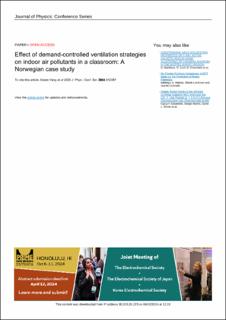| dc.contributor.author | Yang, Aileen | |
| dc.contributor.author | Andersen, Kamilla Heimar | |
| dc.contributor.author | Hak, Claudia | |
| dc.contributor.author | Mikoviny, Tomas | |
| dc.contributor.author | Wisthaler, Armin | |
| dc.contributor.author | Holøs, Sverre Bjørn | |
| dc.date.accessioned | 2024-02-16T09:33:51Z | |
| dc.date.available | 2024-02-16T09:33:51Z | |
| dc.date.created | 2024-01-16T09:18:44Z | |
| dc.date.issued | 2023 | |
| dc.identifier.citation | Journal of Physics: Conference Series. 2023, 2654, 012087. | en_US |
| dc.identifier.issn | 1742-6588 | |
| dc.identifier.uri | https://hdl.handle.net/11250/3118103 | |
| dc.description.abstract | The choice of the minimum ventilation rate (Vmin) in a demand-controlled ventilation strategy can influence energy demand but also introduce outdoor air pollutants. The latter may have direct health effects, as well as affect indoor chemical reactions. In this paper, we evaluate the effect of ventilation rates and operation hours on the level of CO2, nitrogen dioxide (NO2), and ozone (O3) in a classroom during normal use. We compared the baseline ventilation scenario (S0) with a Vmin of 430 m3/h with S1; Vmin of 150 m3/h for normal ventilation operation time (6:30-17:00) and continuous ventilation for 24h (S2). We found that S1 with reduced Vmin would lower the ozone concentration by 35% during the hours before occupancy compared to S0. Moreover, continuous ventilation during night time with a low Vmin resulted in almost as high O3 concentrations as the baseline ventilation scenario. As O3 reacts easily with certain VOCs to produce secondary organic aerosols, the level of Vmin and the ventilation duration would impact the indoor air quality upon entering the classroom. | en_US |
| dc.language.iso | eng | en_US |
| dc.rights | Navngivelse 4.0 Internasjonal | * |
| dc.rights.uri | http://creativecommons.org/licenses/by/4.0/deed.no | * |
| dc.title | Effect of demand-controlled ventilation strategies on indoor air pollutants in a classroom: A Norwegian case study | en_US |
| dc.title.alternative | Effect of demand-controlled ventilation strategies on indoor air pollutants in a classroom: A Norwegian case study | en_US |
| dc.type | Peer reviewed | en_US |
| dc.type | Journal article | en_US |
| dc.description.version | publishedVersion | en_US |
| dc.source.volume | 2654 | en_US |
| dc.source.journal | Journal of Physics: Conference Series (JPCS) | en_US |
| dc.identifier.cristin | 2227393 | |
| dc.relation.project | Norges forskningsråd: 255375 | en_US |
| dc.source.articlenumber | 012087 | en_US |
| cristin.ispublished | true | |
| cristin.fulltext | original | |
| cristin.qualitycode | 1 | |

